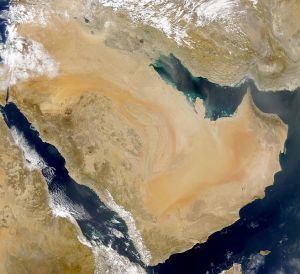
In studies about early human dispersals out of Africa into Asia, scientists have long debated how, when and who moved into the Arabian Peninsula tens of thousands of years ago, and even further back in time. In recent years, researchers have been discovering sites across the Arabian Peninsula that bear on the entire time spectrum of human prehistory, beginning with the Lower Paleolithic (dating arguably in some cases to possibly more than one million years ago). No longer regarded as a cul-de-sac for studies on human evolution and dispersals, the area has quickly emerged as a major theater for exploration and scholarship in the evolving story of early humans and their dispersal across the globe.
Now, in a study conducted by Eleanor M.L. Scerri of the Universite de Bordeaux and colleagues, researchers have quantitatively tested the hypothesis that lithic (stone) tool assemblages uncovered at the site of Jubbah in the Nefud Desert of northern Saudi Arabia exhibited similarities with Middle Stone Age (MSA) stone tools found in northeast Africa. These artifacts are said to have been produced by modern human populations in northeast Africa between 280,000 and 50-25,000 years ago.
What they found has produced a picture more complicated than expected. By analyzing the process the toolmakers used to form their tools, they determined that a mixed demography of early humans occupied the area, as opposed to a homogenous grouping.
“While two Jubbah lithic assemblages [at locations JKF-1 and JKF-12] display both similarities and differences with the northeast African assemblages,” write Scerri et al. in the research abstract of their report, “a third locality (JSM-1) was significantly different to both the other Arabian and African assemblages, indicating an unexpected diversity of assemblages in the Jubbah basin during Marine Isotope Stage 5 (MIS 5, ∼125–70,000 years ago, or ka). Along with evidence from southern Arabia and the Levant, our results add quantitative support to arguments that MIS 5 hominin demography at the interface between Africa and Asia was complex.”*
The detailed report will be published in the Journal of Human Evolution.
________________________________________
*Eleanor M.L. Scerri, Huw S. Groucutt, Richard P. Jennings, Michael D. Petraglia, Unexpected technological heterogeneity in northern Arabia indicates complex Late Pleistocene demography at the gateway to Asia, Journal of Human Evolution.
________________________________________
Travel and learn with Far Horizons.
Read about the most fascinating discoveries with a premium subscription to Popular Archaeology Magazine. Find out what Popular Archaeology Magazine is all about. AND MORE:
On the go? Get the smartphone version of Popular Archaeology as an app or as an ebook.
Popular Archaeology’s annual Discovery Edition eBook is a selection of the best stories published in Popular Archaeology Magazine in past issues, with an emphasis on some of the most significant, groundbreaking, or fascinating discoveries in the fields of archaeology and paleoanthropology and related fields. At least some of the articles have been updated or revised specifically for the Discovery edition. We can confidently say that there is no other single issue of an archaeology-related magazine, paper print or online, that contains as much major feature article content as this one. The latest issue, volume 2, has just been released. Go to the Discovery edition page for more information.







